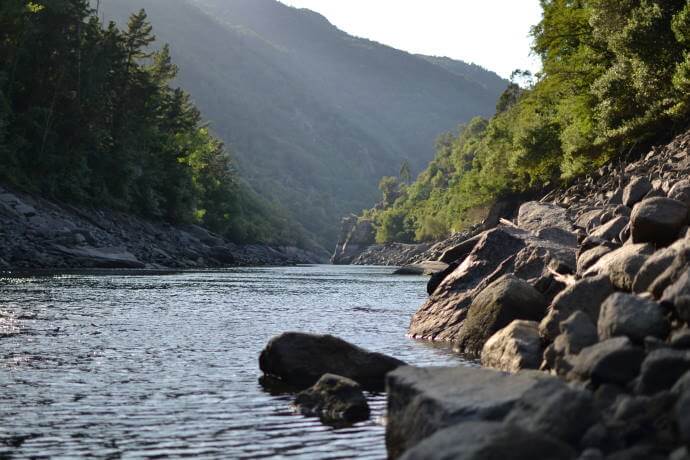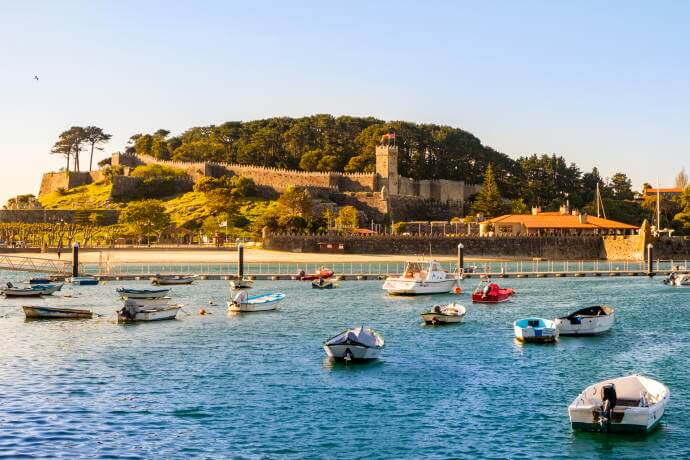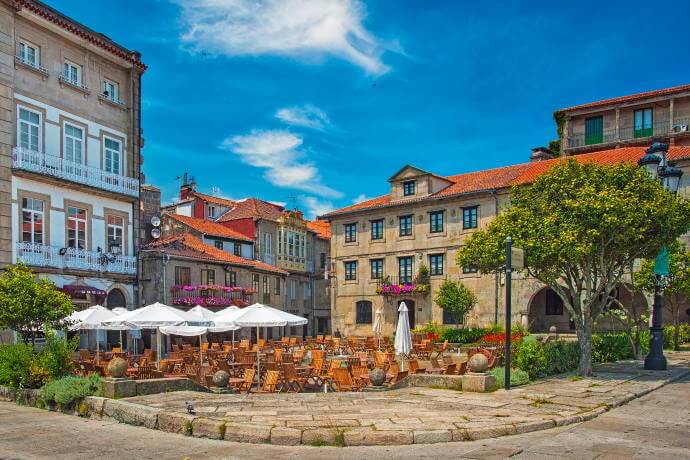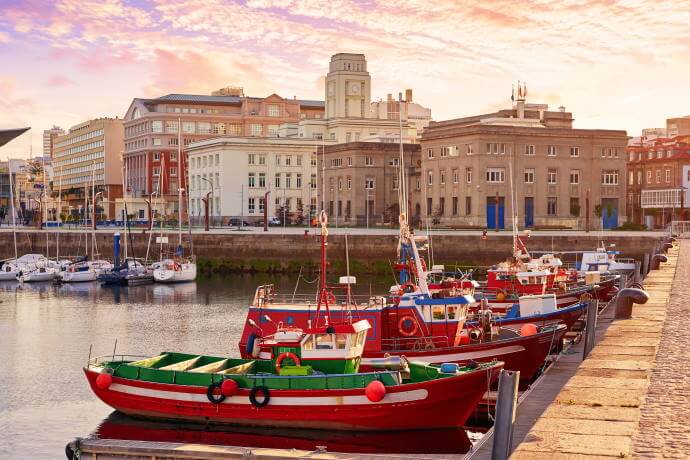After exploring the many attractions of Santiago de Compostela, it's time to visit the very interesting villages and towns in the surroundings! Some of these places are even part of the trails of the famous Way of Saint James. If Santiago de Compostela has enchanted you, wait until you discover the charming neighboring lands, where there are many hidden treasures and much to discover! Here we show you the best daytrips from Santiago de Compostela.
Ourense

Perfect if you like: Thermal baths and medieval cities
Ourense is an excellent option for a daytrip from Santiago de Compostela. This Roman and medieval city is the thermal capital of Galicia and stands out for its charming, maze-like historic center (old town), with its stone houses and buildings and picturesque streets. Although the hot springs and thermal baths are the essence of Ourense, there are many other attractions to explore, from the seven high bridges that cross the Minho River and offer breathtaking views, to the many viewpoints and quaint churches. Some say that the Cathedral of Ourense is one of the most beautiful Romanesque cathedrals in Galicia and even in all of Spain! Visit the cathedral, cross the famous Ponte Vella (the city's landmark and the best-preserved legacy from Roman times), stop at the original and quirky Plaza Mayor full of churches, explore the heated water pools scattered around the outskirts and city center, and visit the many viewpoints to enjoy the panoramic views. Admire the fantastic ancient architecture and be sure to explore the Ribera Sacra wine region, which owes its name to the many medieval monasteries and churches it is home to! Located in the north of the province, this region is known for its stunning landscapes and for producing high-quality wines. Plateaus, hills, centuries-old vineyards cultivated on the cliffs and canyons characterize this almost magical, fog-bound landscape of the Ribera Sacra. Be sure to visit the many natural viewpoints and explore the fantastic river views!
Baiona

Perfect if you like: Beaches and picturesque narrow streets
This lovely seaside town is characterized by its beautiful and attractive bay, around which you will find picturesque narrow cobblestone streets. It is a popular resort, known for being the first Spanish port to receive Columbus' caravel (La Pinta), which arrived here in 1493 after setting off to discover the New World. There is even a museum dedicated to it, the Museo de la Carabela Pinta, where you can see the full-scale replica of the historic ship. This lovely village has a medieval center, several small and pleasant beaches and a very busy seafront. In the old town you will find many hidden bars, cafes and restaurants. On the outskirts of the town, be sure to visit the castle of Monterreal, its medieval walls and the famous Príncipe Tower. As you walk around this fortress, you will be amazed by the magnificent views! It is the perfect place to watch the sunset. Currently, this fortress is a parador. The small and charming 13th century church of Santa María is also worth a visit! Note that Baiona is on the "Portuguese Way" of the Camino de Santiago.
Pontevedra

Perfect if you like: Lively cities and rivers (rías)
Pontevedra is a welcoming city full of life, with a historic center considered the most important in Galicia after Santiago de Compostela! It is a city with a long maritime and mercantile tradition. In the 16th century it was the largest city in Galicia and a very important port. Its elegant historic center is full of pleasant terraces open until dawn and beautiful churches, such as the Church of San Francisco. The lively squares, such as the Praza da Leña or the Praza da Verdura, are full of shops, markets, cafés and tapas bars. Along the streets, you can admire the stone architecture and the emblazoned houses. Some of the best attractions of this destination are the Museo de Pontevedra and the ruins of San Domingos, which allow you to understand the history of this charming city. The 16th century Basilica de Santa María la Mayor in late Gothic style is also worth a visit. The long narrow Ria de Pontevedra is almost like a Scandinavian fjord, with trees on both sides. It is probably one of the most famous of the Rias Baixas. To the north lies Combarro, a city seemingly plucked from the medieval era, and Sanxenxo, a port town that is also a hidden natural resort. To the south are several wild beaches and other picturesque coastal villages. Walking along the river and exploring the hidden magical corners is a must once you are in Pontevedra!
A Coruña

Perfect if you like: Cosmopolitan cities and seaside walks
A Coruña is a quiet port city with a fabulous seafront, known for its beautiful beaches and busy harbours. It is one of the most prosperous cities in the region, where the sea breeze and the sound of seagulls are a constant. Sailors used to call it the "glass city" because of the modern-style glass façades that dominate the view from the port. A Coruña has its own cosmopolitan way of life with a very lively bar and tavern culture. There's nothing quite like sitting on a terrace in the Praza de María Pita, the most central square in the compact old town, sipping a glass of wine and soaking up the cheerful atmosphere. When in Coruña, be sure to walk along the seaside board walk, that is said to be the largest seaside board walk in Europe! Also visit the Torre de Hércules, the city's landmark, which has been declared a World Heritage Site by UNESCO, and climb the stairs of this tower for breathtaking panoramic views of the city and the coast. Explore the city's many museums and end the afternoon in one of the romantic gardens to watch the sunset. If you are a wine lover, be sure to explore the wine bars in the Zona de Vinos!
Fisterra

Perfect if you like: Fishing villages, sea views and traditions
Ancient sailors believed that this was the westernmost point on earth and that therefore at Cape Fisterra, a granite promontory, the world ended. In other words, this typical fishing village was the limit of known lands, the literal end of the world. The name of this town means "finis terrae", which means “end of the earth”. This municipality is characterized by rugged landscapes and beautiful and impressive beaches. Watching the sun go down over the ocean is a fantastic experience. The biggest attraction of this town is undoubtedly the lighthouse, which lights up with a magical atmosphere in the late afternoon. This lighthouse is the westernmost in Europe, and it is said that on a clear day you can see the border with Portugal from here. This city has also become an important destination for travelers on the Camino de Santiago. It is a must-see, as it is considered by many to be the true end of the Camino de Santiago. In fact, many pilgrims have a tradition of arriving at this promontory and burning a piece of clothing or footwear they have worn along the Camino, almost as if it were a purification ritual or perhaps a symbolic ending. The fishing village is famous for its harbor, fort, restaurants and beautiful beaches. The narrow and winding streets are worth a stroll! If you have time, visit the interesting Igrexa de Santa María das Areas, a medieval church from the 12th century.



